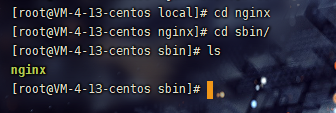在拥有服务器后,需要将程序部署到服务器中,然后通过访问服务器地址加端口来展示网站,那就需要使用到nginx
一、下载
打开 Nginx官方下载链接(后缀tgz) 进行下载,当前最新的1.9.9本,下载完成后一般将文件放置于 /usr/local/目录下
二、安装
1. 解压文件
使用以下命令进行解压,解压完成后可看到local目录下多了一个nginx-1.9.9的文件夹
tar zxvf nginx-1.9.9.tar.gz
2. 编译
解压完成后,进入解压后的文件夹内,使用configure命令检查安装环境
# –prefix指定nginx的安装目录,默认路径就是/usr/local/nginx
./configure --prefix=/usr/local/nginx --with-http_stub_status_module --with-http_ssl_module以上操作完成后,输入以下命令进行编译
make编译完成后,输入以下命令安装编译程序
make install以上步骤全部完成后,进入 /usr/local/nginx/sbin 目录下查看是否存在nginx,如果存在即安装成功
三、启动Nginx
1.启动
进入 /usr/local/nginx/sbin/ 目录下,输入以下命令即可
./nginx2. 检查启动结果
在浏览器中输入ip地址,查看页面,如见到以下页面即安装成功(nginx默认监听的是80端口)
以上操作完成后,及安装成功
四、Nginx配置详解
打开 /usr/local/nginx/conf/nginx.conf 文件进行编辑
#user nobody;
worker_processes 1;# 工作进程:数目。根据硬件调整,通常等于cpu数量或者2倍cpu数量。
# 错误日志存放路径
#error_log logs/error.log;
#error_log logs/error.log notice;
#error_log logs/error.log info;
# nginx进程pid存放路径
#pid logs/nginx.pid;
events {
worker_connections 1024;# 工作进程的最大连接数量
}
http {
include mime.types;# 指定mime类型,由mime.type来定义
default_type application/octet-stream;
# 日志格式设置
#log_format main '$remote_addr - $remote_user [$time_local] "$request" '
# '$status $body_bytes_sent "$http_referer" '
# '"$http_user_agent" "$http_x_forwarded_for"';
# 用log_format指令设置日志格式后,需要用access_log来指定日志文件存放路径
#access_log logs/access.log main;
# 指定nginx是否调用sendfile函数来输出文件,对于普通应用,必须设置on。
# 如果用来进行下载等应用磁盘io重负载应用,可设着off,以平衡磁盘与网络io处理速度,降低系统uptime。
sendfile on;
# 此选项允许或禁止使用socket的TCP_CORK的选项,此选项仅在sendfile的时候使用
#tcp_nopush on;
# keepalive超时时间
#keepalive_timeout 0;
keepalive_timeout 65;
# 开启gzip压缩服务
#gzip on;
# 虚拟主机
server {
listen 80;# 配置监听端口号
server_name localhost;# 配置访问域名,域名可以有多个,用空格隔开
# 字符集设置
#charset koi8-r;
#access_log logs/host.access.log main;
location / {
root /usr/demo; # 项目路径
index login.html; # 需要访问的html文件名称
}
# 错误跳转页
#error_page 404 /404.html;
# redirect server error pages to the static page /50x.html
#
error_page 500 502 503 504 /50x.html;
location = /50x.html {
root html;
}
# proxy the PHP scripts to Apache listening on 127.0.0.1:80
#
#location ~ \.php$ {
# proxy_pass http://127.0.0.1;
#}
# pass the PHP scripts to FastCGI server listening on 127.0.0.1:9000
#
#location ~ \.php$ {
# root html;
# fastcgi_pass 127.0.0.1:9000;
# fastcgi_index index.php;
# fastcgi_param SCRIPT_FILENAME /scripts$fastcgi_script_name;
# include fastcgi_params;
#}
# deny access to .htaccess files, if Apache's document root
# concurs with nginx's one
#
#location ~ /\.ht {
# deny all;
#}
}
# another virtual host using mix of IP-, name-, and port-based configuration
#
#server {
# listen 8000;
# listen somename:8080;
# server_name somename alias another.alias;
# location / {
# root html;
# index index.html index.htm;
# }
#}
# HTTPS server
#
#server {
# listen 443 ssl;
# server_name localhost;
# ssl_certificate cert.pem;
# ssl_certificate_key cert.key;
# ssl_session_cache shared:SSL:1m;
# ssl_session_timeout 5m;
# ssl_ciphers HIGH:!aNULL:!MD5;
# ssl_prefer_server_ciphers on;
# location / {
# root html;
# index index.html index.htm;
# }
#}
}编辑完成后,重启Nginx即可生效
五、Nginx基础命令
./nginx # 启动nginx
./nginx -s stop # 先查出nginx进程id再使用kill命令强制杀掉进程
./nginx -s quit # 待nginx进程处理任务完毕进行停止
./nginx -s reload # 重启nginx每次编辑完nginx.conf文件后都必须重启nginx
